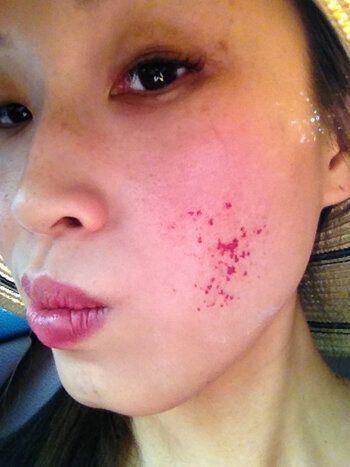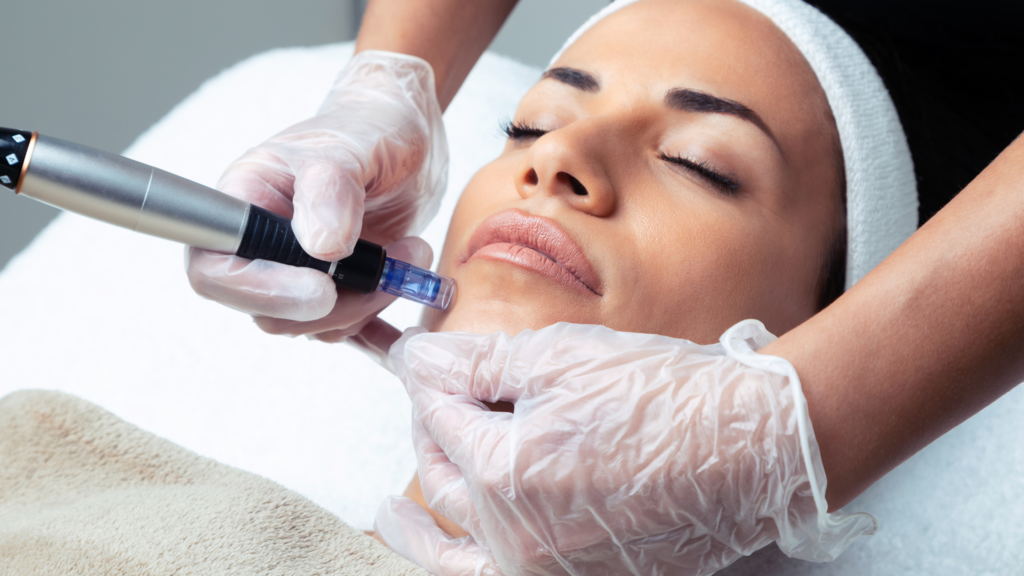Table of Contents
ToggleTL;DR
Deep Phenol Peels and TCA Overview:
- Deep phenol peels are the most aggressive form of chemical peels, shedding a portion of the entire epidermis to reveal fresh skin.
- Phenol, derived from petroleum, is the key component, causing restricted injury to reduce facial wrinkles.
Understanding Brown Skin for Chemical Peels:
- Brown skin has higher melanin concentration, more cell layers, sweat glands, and ceramide content.
- Despite high ceramide levels, brown skin is sensitive to pigmentation changes,
Immediate Reactions to Deep Phenol & TCA Peels:
- Irritation, redness, color changes, burns, scars, crusting, scabs, swelling, allergies, and infection are common immediate reactions.
- Increased sensitivity to sunlight is a notable side effect, requiring avoidance of sun exposure.
Long-Term Complications on Brown Skin:
- Persistent erythema, edema, blistering, milia, hyperpigmentation, depigmentation, herpes simplex infection, atrophy, changes in skin texture, and delayed healing are potential long-term complications.
- Complications like persistent erythema may indicate potential scarring, and milia can occur in the initial healing weeks.
Nowadays, chemical peels are one of the best solutions to reduce the appearance of blemishes and signs of aging, which make you look younger than your age.
So, many people are doing the strongest deep phenol peel due to their high-intensity level, and skin penetration capabilities and get exceptional results. However, being the toughest type of chemical peel, it comes with certain risks, and side effects and can have dangerous effects on your skin.
Deep phenol peel doesn’t suit Indian brown skin or dark skin tone because of its high melanin content, and thus, high risk of developing PIH. As dark skin responds to injuries or inflammation, it produces extra melanin and develops dark spots and patches.
The aggressiveness of deep phenol peel causes scars and uneven tone. Indian skin gets more sensitive to the sun after the treatment intensifies the sun damage risks, develops pigmentation, and delays healing, which causes irritation, redness, and infection.
As deep phenol peel is an aggressive skin treatment, consulting a skilled doctor is crucial before getting it done. At CNF, our doctor checks your skin type, and melanin content and recommends the right treatment to deliver the desired results rather than performing deep phenol peel because of which your skin may have severe side effects
Overview of Deep Phenol Peels & TCA
Here is an overview of deep phenol peels & TCA that you should know before doing it:
Definition and Purpose
A deep phenol peel is the deepest and most aggressive form of chemical peel, which sheds a portion of the entire epidermis and reveals fresh skin underneath. Phenol, the organic molecule, acquired from petroleum elements, can be generated deeply inside your skin and thus, used in aesthetic treatments.
It causes a restricted injury, which can visibly reduce the appearance of facial wrinkles post-healing. As phenol contains acidic properties, it is widely used in skincare products.
Unlike AHA/BHA peel, a deep phenol peel gets into the superficial layer and gently sheds dead cells on your skin’s topmost layer. Since phenol peel is very aggressive, it doesn’t suit Indian skin tones with a high melanin content. A phenol peel works well with people with mild to deeper acne scars, sun damage spots, and wrinkles.
Phenol, also called “carbolic acid”, removes your skin’s outer layer. A deep phenol peel is a skin resurfacing treatment whose purpose is to remove damaged cells, lighten acne scars, and boost collagen production in your skin. You will get a clearer and younger skin after the treatment.
Common Usage Of Deep Peels in Skincare
A phenol peel is a commonly used ingredient in the skincare industry to cure skin conditions, such as acne and eczema. Since phenol acts as a disinfectant, it can heal your skin when combined with other treatments.
Phenol peel is non-invasive that causes tiny tears in your skin which produces more elastin and collagen post the treatment. The molecules in the peel deeply penetrate your skin’s top layer and reduce the appearance of discolorations and blemishes.
Skincare products containing phenol peel can exfoliate dead cells from the pores and cure acne breakouts. You can apply phenol peel products on your face as an inclusion of a multidisciplinary process when treating freckles and age spots. Phenol peel controls sebum production and shrinks the large open pores in your skin. As the excessive oil production controls, it minimize the chances of pore blockages and decreases the size of pores.
Understanding Brown Skin For Chemical Peels
If you have a brown skin tone, you should know its unique properties and common challenges it faces before getting the deep phenol peel.
Unique Properties of Brown Skin
Here are the key properties of brown skin:
High Melanin Concentration
Brown skin has a higher level of melanin concentration than fair skin and thus, has a higher risk of hyperpigmentation as the pigment cells react quickly. As brown skin contains more melanin, it gets more protection against harmful sun rays. Dark skin has the same number of melanocytes as light skin. However, such cells produce larger melanosomes.
More Cell Layers, Sweat Glands, and Ceramide Content
Brown skin contains more cellular layers, which makes it more compact and less prone to wrinkles and aging. Dark skin has more tiny blood vessels and sweat glands and is thus, a little oilier than fair skin. It also tends to get drier as its transdermal moisture loses more than light skin.
Asian skin has a high level of ceramide that helps in maintaining a strong skin barrier, holding moisture, protecting against irritants, and controlling moisture loss. A high ceramide content in Indian brown skin helps in strengthening the barrier and keeps it hydrated.
Sensitivity to Pigmentation Changes
Even after having a high ceramide content, brown skin is quite sensitive to pigmentation changes. Ceramides and sensitivity in your skin have a complicated relationship, which varies depending on multiple factors, such as environmental elements, genetic predisposition, allergies, irritation from skin care product ingredients, and other skin disorders. As brown skin is extremely sensitive to pigmentation changes, it demands special attention.
Immediate Reactions to Deep Phenol & TCA Peels
Here are the immediate reactions your skin may have after getting deep phenol peel:
Irritation
Your skin may irritate a little after doing the deep phenol peel. You can apply petroleum jelly or protective ointment to soothe your skin.
Redness

Some redness appears on your skin after the peel treatment. Redness can also get severe and can fade in a few weeks or months.
Colour Changes

The treated area may get lighter or darker than the surrounding skin.
Burns and Scars

A deep phenol peel may cause burns and scars, mostly on your face’s lower portion. You can take steroid medications or antibiotics to reduce the appearance of scars.
Crusting and Scabs

After the deep phenol peel, you can see crusting and scabs appearing on your skin that may stay for 7 to 10 days.
Swelling

Once you get the treatment, you can see swelling on your face, mainly near your eyes. You can subside the swelling by applying an ointment.
Allergies

The peel with a high frequency and concentration may irritate your skin. Your skin may experience itching and stinging when it gets allergic after the peeling treatment.
Infection

A deep phenol peel may cause viral, fungal, or bacterial infection. People with herpes tend to get outbreaks after the peeling treatment.
Increased Sensitivity to Sunlight

The peel treatment increases your skin’s sensitivity to sunlight by boosting the formation of sunburn cells and cyclobutane pyrimidine dimers. Avoid sun exposure after 1 week of the deep phenol treatment to protect your treated skin from harmful UV rays.
Long-Term Complications Of Deep Peels On Brown Skin
Besides mild side effects, brown skin may face long-term, severe, and life-threatening complications below after getting a deep phenol peel:
Persistent Erythema

Persistent erythema is your skin staying erythematosus more than that’s normal for a chemical peel. Erythema tends to fade away in 2 to 3 months after getting the deep phenol peel. If erythema stays on your skin for more than 3 months, you should beware as it indicates potential scarring.
Edema

Edema tends to occur in 24 to 72 hours after getting the deep phenol peel. You should be careful during peeling if you have dry, thin, and atrophic skin, mainly in the periocular region as edema may occur in this area due to deeper penetration. Tachypnea, hoarseness, and stridor may develop a day after phenol peeling because of larynx hypersensitivity reaction irritated by cigarette smoking.
Blistering

Young people with sagging periorbital skin may experience blistering after the peeling treatment. A deep phenol peel may cause blistering, vesiculation, and epidermolysis, mostly in sensitive areas, such as the perioral region and nasolabial fold.
Milia

Milia are cysts that occur as an inclusion of the deep phenol peel healing process. You get milia in the initial few weeks of the healing period. The post-peel maintenance of the deep peel causes milia by blocking the pilosebaceous units by applying ointments. Patients with thicker skin are more exposed to the risks of getting milia.
Hyperpigmentation

Hyperpigmentation may develop on your skin anytime after a deep phenol peel. When not treated effectively, hyperpigmentation may be persistent. The complications from the peel can be dyschromia or transient hyperpigmentation, mainly in brown-skinned patients. Nevi and lentigines may occur temporarily when the current sun damages get cleared. Solar lentigines may return post a peel as the melanocytes responsible for pigmentation stay under the level of peel.
De-pigmentation

You can see a bleaching effect after the deep phenol peel mostly in the jaw neck area where the untreated neck skin touches the periorbital skin or rejuvenated cheek. The bleaching gets less noticeable and complicated in patients getting regional peeling since the melanocytes lose their abilities of melanin production.
Herpes Simplex Infection

Herpes simplex infection occurs on your face and perioral region suddenly as grouped erosion, which aches. You can easily treat active herpetic infections with antiviral agents. When herpes simplex infection is detected and treated early, it doesn’t scar.
Atrophy

Atrophy is the loss of normal skin marks when your skin has no scars. It tends to occur after getting phenol peel and does not usually appear with other peels. Periorbital skin is likely to get atrophy as it is thinner than most of the facial portions.
Changes in Skin Texture

As the stratum corneum gets removed after a deep phenol peel, enlarged pores may appear temporarily. When the wounding agent can’t peel under the defect or do an even wounding depth because of the lack of surfactant, then, you get an uneven skin tone. People suffering from telangiectasias may have a worse skin texture after the deep phenol peel, which you can treat with laser treatment.
Delayed Healing
The healing gets delayed because of granulation tissue prolongation taking 7 to 10 days. Diminished skin appendages may damage epidermis regeneration with slow wound healing. The vellus hair may show that the epidermis can regenerate after a peel despite previous cancer radiation.
Safe Alternative Treatments To Deeper Peels for Brown Skin
Almost all types of beauty treatments can do wonders for light skin. However, brown-skinned people may not do all those aesthetic treatments, like deep phenol peel, as they may experience severe side effects. Here are the alternative treatments that may suit brown skin:
Lighter Chemical Peels

Chemical peels suit all types and colors of skin, even brown skin. This peeling treatment exfoliates the top layer of your skin and boosts cell turnover without causing inflammation. Glycolic acid, salicylic acid, and lactic acid peel are safe for dark skin tones. Lactic acid is an AHA peel, which works like glycolic acid and cures skin concerns in dark-skinned people. Lactic acid, which is acquired from soured milk, suits sensitive skin. The best thing about chemical peels is that they have little downtime. However, repeated sessions are required to maintain the results.
Laser Treatment

Laser treatment is perfect for getting clear and smooth skin. It works well in brown skin tone by reducing the appearance of wrinkles, fine lines, acne, pigmentation marks, and large pores. You can see an exceptional improvement in your skin texture immediately after the treatment. The low-density and low-level laser can superficially exfoliate the top layer of your skin. This treatment can cure your fine wrinkles, and melasma and reduce the size of pores. Laser treatment has a downtime of 1 to 5 days. With repeated sessions, you can maintain the results.
Botox

Botox is an extremely popular aesthetic treatment globally, which is safe for brown skin. Celebrities worldwide get botox injections to reduce the appearance of wrinkles and fine lines on their forehead, around the eye corners, and in between eyebrows. You can get Botox injections to slim down and contour your jawline. The treatment procedure takes approximately 10 minutes. The results are visible in 4 to 6 days and the smooth lines stay for 3 to 4 months. You can get it done anytime when you feel the results from the previous session have faded.
Dermal Fillers

Dermal fillers are a safe aesthetic treatment option for brown-skinned people. When injected into your skin, dermal fillers can restore facial volume, add contour to jawline and cheeks, treat dark hollows and circles below the eyes, and even plump lips. Filler injections have no risks but may have mild side effects, such as swelling and bruising. The dermal filler injection is a great choice to enhance your overall beauty as it is non-invasive and has minimum downtime. The results stay for 5 to 12 months depending on the treated area. HA fillers, such as Juvederm and Restylane can deliver the best results.
Microneedling

Microneedling is a beauty treatment suited for skin tones varying from black to dark olive. This treatment has no risks as it involves no heat. Thus, people with darker and Indian skin tones don’t experience PIH. This treatment hydrates facial skin and reduces the appearance of acne scars, wrinkles, and fine lines. It gets inside your facial skin, promotes your body’s healing process, and boosts collagen production. This treatment takes almost 20 minutes with a minimum healing time. Your skin may heal in a day and you can resume your normal activities immediately after the treatment. You get radiant, glowing, and healthy skin, which you can maintain with repeated sessions.
Microdermabrasion

Microdermabrasion is a beauty treatment that removes your skin’s top layer by deep cleansing your skin. This treatment reduces the appearance of acne scars and blemishes and brightens your brown skin. It helps your skin repair itself by exfoliating the topmost layer and boosting the production of cells and collagen, a protein that smooths your skin. The treatment duration is 15 to 30 minutes. The total number of required sessions depends on your skin condition and desired goals. The doctor can suggest the right treatment schedule to fulfill your aesthetic desires. 6 to 10 sessions scheduled at an interval of 1 to 2 weeks can deliver the best outcomes.
Talk To Our Skin Whitening Expert Today!
No Obligations! Just jump on a quick call with our Skin Whitening expert and know what kind of treatment will suit you the best.
Either way you will get some actionable tips to reach your skin goals faster.








